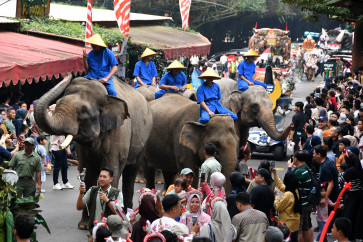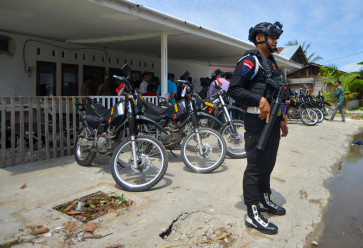Popular Reads
Top Results
Can't find what you're looking for?
View all search resultsPopular Reads
Top Results
Can't find what you're looking for?
View all search resultsHow to make `pempek'
First, mix minced fish meat with an equal amount of water
Change text size
Gift Premium Articles
to Anyone
First, mix minced fish meat with an equal amount of water. Add salt to taste while stirring. Then add a little tapioca (sago) and keep stirring until the mix is smooth. Eventually this forms dough that isn't sticky and can be easily shaped.
The way pempek is made influences its texture and aroma, especially during the step of stirring in the tapioca flour to produce the dough. While stirring it is important to avoid trapping air bubbles inside the dough.
After the dough has been formed it can be made into various types of pempek or other foods such tekwan, model, celimpungan, or kemplang (chips). Various types of pempek can be made from the dough base.
The next step is to cook the dough, whether by boiling, steaming, frying or grilling. It usually takes around 20-90 minutes to boil pempek, especially for pempek lenjer. The aim of boiling is to preserve the essence that develops during the gelatinization process, so that the granules of essence develop and the protein is denaturized. This should be done at 80 degrees Celsius for 30 minutes.
The boiling and steaming processes should be closely supervised so that few nutrients are lost. However, the protein, vitamins and minerals from the materials can be dissolved in boiling water or steam, so that the level of nutrients in pempek decreases.
After being cooked the pempek is drained and chilled for a little while to ensure it doesn't deteriorate quickly. Pempek has a relatively short shelf life; it can only stand for around three days at room temperature. Kept in a refrigerator, its shelf life can increase to around four weeks. However, if it is vacuum-packed and kept frozen it can be preserved for 40 days or more.
If kept too long a skin will form on the surface of the pempek and affect the flavor. Another way to help preserve the pempek is to remove the water that sticks to its surface using a clean cloth. If you're planning to take it on a long journey, sprinkle the surface of the pempek with tapioca flour to keep it dry.
Poppy free: An Afghan farmer looks at an anti-narcotics poster in the remote village of Talbozag in Badakhstan province. Until 2006, Badakhstan was one of the main opium-growing areas in Afghanistan, but last year its output fell by 95 percent.










